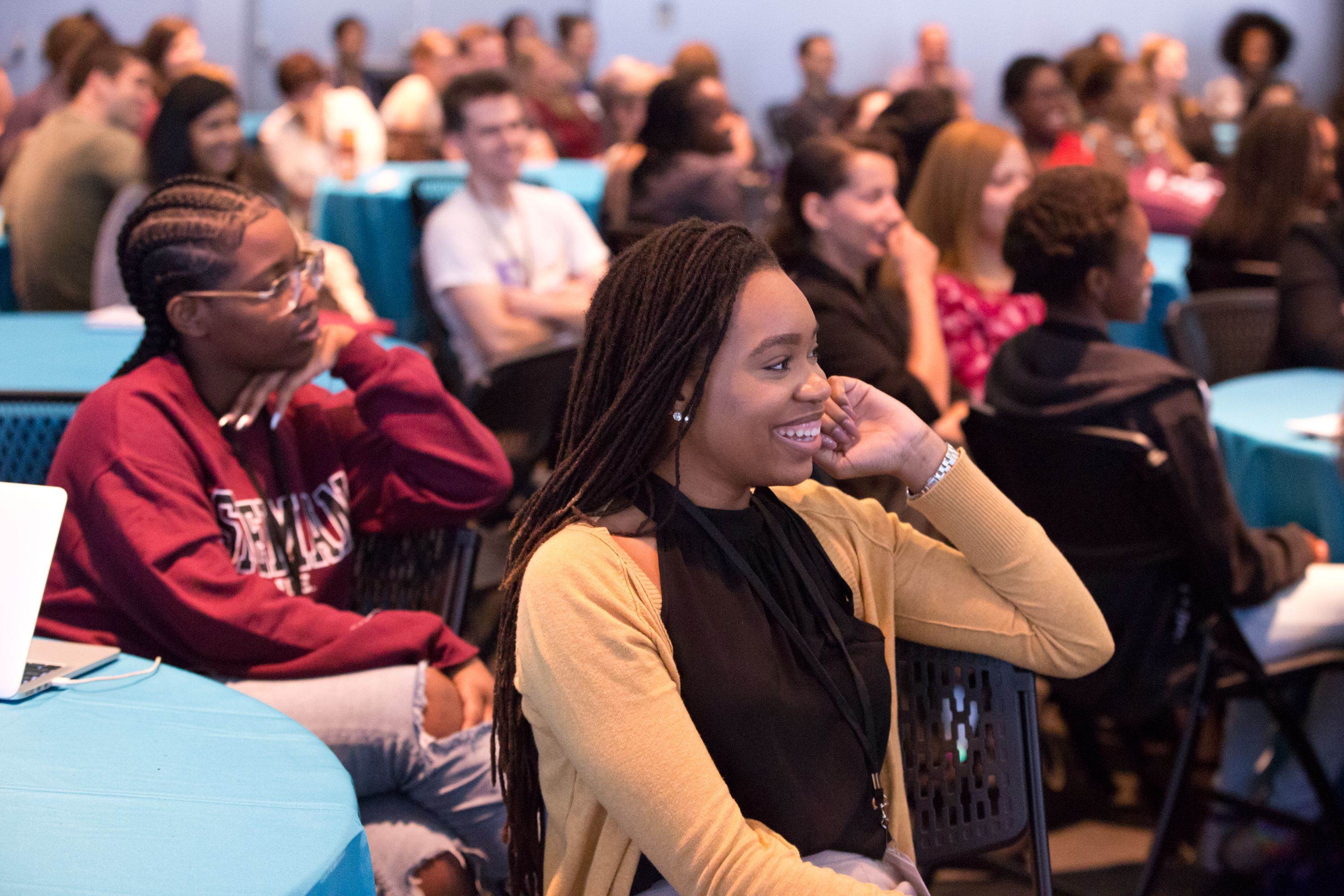
Not that many years ago, Megan Smith ’86, SM ’88 was poised to embark on a career in technology, a field long dominated by white men. Now, the MIT alumna is the United States’ Chief Technology Officer, and she’s determined to tamp down gender bias and step up diversity, especially in STEM.
“Our biggest challenge in tech and innovation is that we think certain people do it and certain people don’t,” Smith told an audience of some 250 attendees, predominantly women, at the Sept. 9 MIT Media Lab conference, called No Permission, No Apology. The White House CTO, who was previously a Google executive, said that after centuries of discrimination, we’re in an era of unconscious or implicit bias. “We’re not aware we’re doing this, or it’s institutionalized. So once we see it, we should fix it. We are capable of dealing with everything we set our minds to and prioritize; we just haven’t made that a priority.” She added that everyone stands to gain: “In addition to the inclusion of all because it’s the right thing to do, it’s also the best thing to do in terms of innovation and economics.”
Smith’s keynote speech clearly resonated among the crowd of prospective Program in Media Arts and Sciences (MAS) candidates from Wellesley and Spelman colleges, and the Meyerhoff Scholars Program at the University of Maryland, Baltimore County (UMBC) as well as undergraduate and graduate students from across MIT. Aliyah Smith, a UMBC sophomore who’s majoring in mechanical engineering, said after hearing Megan Smith’s stories about women who pioneered scientific and technological advances, she’s even more motivated to contribute and be recognized now. “I was very inspired to hear about the work that other women have done in the past. It’s always good to remember that women have not all of a sudden become interested in technology; we just haven’t been acknowledged.”
Entrenched inequities
But in spite of efforts over the past decade to attract more women and people of color to careers in science, technology, engineering, and mathematics (STEM), the workforce is no more diverse these days than it was in 2001. That’s according to recent research by Change the Equation, a coalition of Fortune 500 firms, and the 2016 US News/Raytheon STEM Index, which also shows that by most measures gender and racial gaps remain entrenched. Meanwhile, a study by the University of Chicago and Stanford University released in August this year highlights the economic and creative benefits for industry of diversifying talent.
Such findings are what prompted this first such event at the Media Lab. “The essence of the conference is community building,” said Monica Orta, assistant director of diversity and student support at the MIT Media Lab. “It isn’t enough to create access to a space; we also have to make that space one in which all members can thrive. The conference seeks to shine a light, and build on the ways we can all bring each other up.”
Breaking down ideas
The daylong conference offered a slate of sessions including breakouts on succeeding in grad schools and beyond, steering startups, developing financing strategies, overcoming doubt, and counteracting “bystander dilemma.”
Robbin Chapman led a discussion on outsmarting “imposter syndrome.” She’s associate provost and academic director of diversity and inclusion, and a lecturer in the Department of Education at Wellesley College. Chapman, who earned her MS and PhD degrees in electrical engineering and computer science at MIT, said that since she got her doctorate in 2006, there are still differential outcomes in STEM, “And we need to keep thinking together about how to remove or address barriers, and find pathways that circumvent barriers. We can tap into new institutional structures that can help offset the fact that a group lacks privilege.”
Men as allies
There was a session on how men can effectively help bring gender balance to the technology industry. Lauren Kinsey, an advocate for gender equity in technology, led the discussion, citing research showing the benefits of gender balance, and told participants that “men can use the leverage they have to help change the equation.” That’s something Rahul Bhargava has been trying to do in his career. A research scientist in the Center for Civic Media at the Media Lab, Bhargava said that as a facilitator and a teacher he’s now looking at the readings he assigns, “making sure I’m not leaving out a bunch of voices, and trying to ensure the examples I use are inclusive. And, as Megan Smith said in her keynote, making sure I’m not revising history in some way based on what I’ve been exposed to but actually digging to find those voices that aren’t usually highlighted.” Bhargava also wrote a live blog about another session, which was about overcoming the “design default” that overlooks diverse audiences.
“Diversifying spaces is an intentional act,” said Orta. “By and large, people’s social and professional circles reflect their own identities. When we are tasked with referrals or spreading the word, we are tapping into a network that looks, and often thinks, like we do. To stretch ourselves beyond that takes work. This is true for men in spaces that were created with only them in mind. Being cognizant of the how to pull others in and the ways in which we make a space more or less welcoming has a huge impact.”
Influence, persuasion, and presence
“You need mentors, advocates, connectors, and accountability partners who are familiar with your work and help you get it done,” Chapman said. She recommended developing a “thrive mosaic,” a career-long, evolving network of personal resources. You need to build concrete support in ways that will help you become successful, within academia and elsewhere. That mosaic maps to anything you’re going to do anywhere.”
And, establish your presence, advised Denise Minor. Before she became senior partner at MindSpring Metro DC, she’d worked 28 years as a special agent with the FBI. In the conference session she led, Minor recalled her first day on the job with the agency: “There were 12 old guys, and they said. ‘Oh, you want to be a man or something? Why are you an FBI agent?’ Now, if I had let their perceptions of me cloud me, then I would’ve thought, ‘Oh, maybe I shouldn’t be -.’ Instead, I said to them, ‘You know what, the FBI really needs a different perspective — a female perspective, and an African American perspective. I bring something to the table that you need. And if you guys are all smart enough, you’ll use my abilities and work with me.’” Minor closed the session by urging the young women to forget the internal voices that cause self-doubt, and turn off the mind chatter that undermines self-confidence.
This was the first No Permission, No Apology conference at the Media Lab, but Orta said it’s not the last word on the long-standing issues of gender and race equity in STEM. “We want to meet the needs of the community by working with our students to bring their ideas about how to address issues of diversity to life.”






